The Philips PML8709 is a model that stands out in the offerings of the Chinese-Dutch manufacturer due to its uniqueness. Instead of the classic Philips operating system - TitanOS, we find the already well-known Google TV here, which provides extensive personalisation options and access to a vast library of applications. This television tempts us with very good contrast on one hand, while on the other hand, it surprises with a few unusual design decisions. In terms of picture quality, the PML8709 offers very good contrast, which, combined with wide colour gamut coverage, ensures excellent colour reproduction – especially after calibration. Despite a 60 Hz panel, the television is also suitable for occasional gaming thanks to support for features such as ALLM, VRR, and a low input lag of around 13 ms. On the other hand, Philips has deprived this model of one of the greatest advantages of its televisions – the Ambilight system. This unexpected move may disappoint many brand fans. Another weak point is performance in HDR – despite promising contrast results, the television performs averagely in this category. The average brightness and issues with details in brighter scenes give the impression that something has evidently gone wrong in the implementation of this feature. The Philips PML8709 is a television full of contrasts. On one hand, it offers solid black quality and interesting solutions for gamers, while on the other hand, some limitations, such as the lack of Ambilight and average brightness, mean that it is not a model without flaws. It is a good choice for those who value the versatility of Google TV and are looking for a television for everyday use.
- Matching (Score)
- Our verdict
- TV appearance
- Where to buy
- Contrast and black detail
- HDR effect quality
- Factory color reproduction
- Color reproduction after calibration
- Smoothness of tonal transitions
- Image scaling and smoothness of tonal transitions
- Blur and motion smoothness
- Console compatibility and gaming features
- Input lag
- Compatibility with PC
- Viewing angles
- TV efficiency during daytime
- Details about the matrix
- TV features
- Apps
- Playing files from USB
- Sound
Philips PML8709 vs Samsung QN85F
Direct compare
QN85F

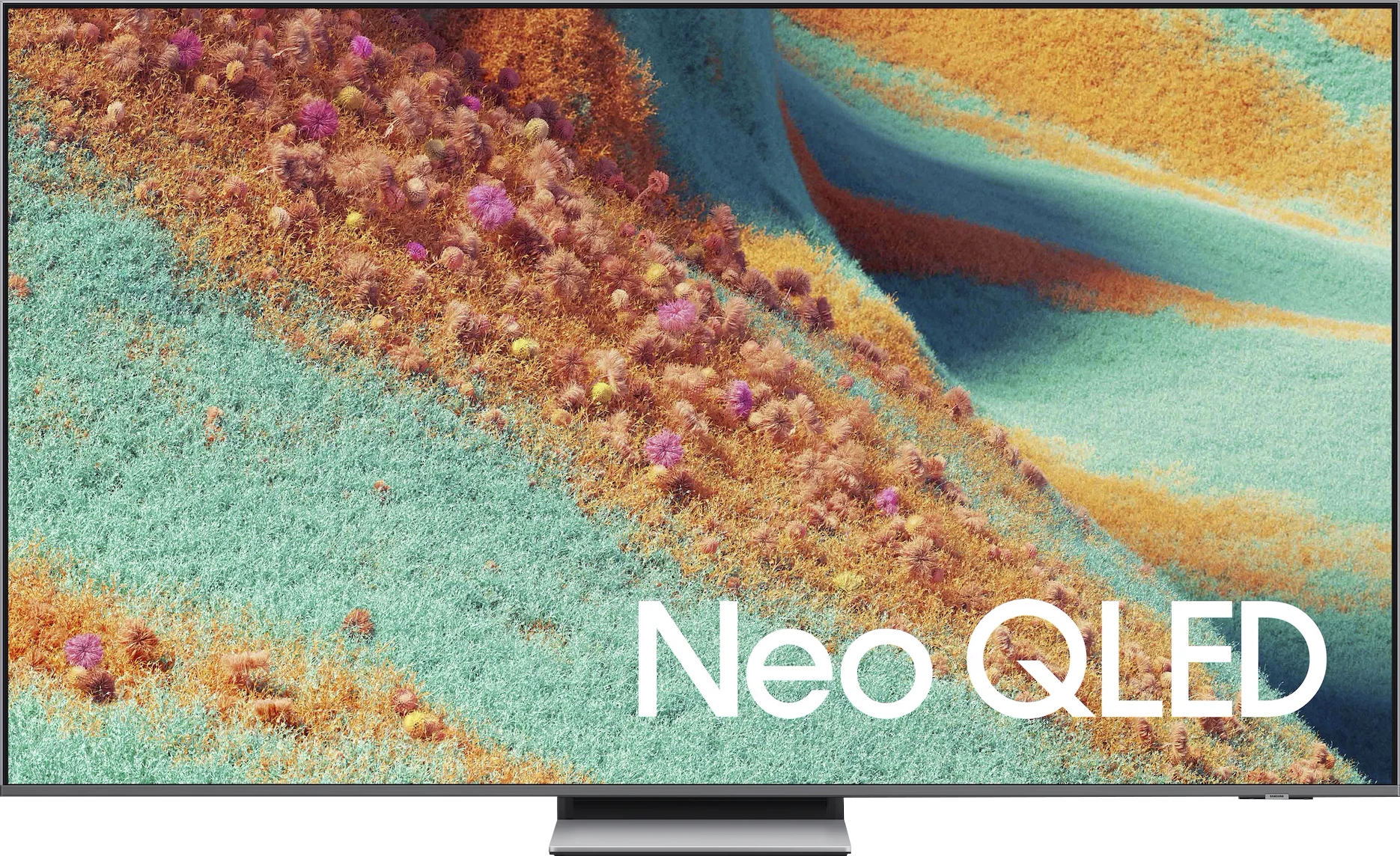
Panel type: LCD VA
Resolution: 3840x2160
System: Google TV
Model year: 2024
Complete the survey to find out the result

Panel type: LCD VA
Resolution: 3840x2160
System: Tizen
Model year: 2025
Complete the survey to find out the result

Overall rating
6.1
7.6
Movies and series in UHD quality
6.3
7.5
Classic TV, YouTube
6.6
7.2
Sports broadcasts (TV and apps)
5.6
7.0
Gaming on console
7.2
8.7
TV as a computer monitor
3.5
8.4
Watching in bright light
4.8
6.9
Utility functions
6.5
7.3
Apps
9.6
8.7
Sound quality
5.1
7.6
Complete the survey to find out what fits your preferences
Advantages
Google TV operating system – intuitive and versatile
Very good contrast
Very good coverage of the DCI-P3 and BT.2020 colour palettes
Low input lag - around 13 ms
Support for ALLM, VRR, and HGiG in gaming mode
High HDR brightness (even 1700–1800 nits)
Very good contrast and deep blacks
2 times higher number of dimming zones than its predecessor (55")
144 Hz panel with VRR and ALLM support
Unique Game Motion Plus feature – a unique smoother for gaming
Low input lag
Matte screen finish works great during the day combined with high brightness
Advanced Tizen platform: with AirPlay, SmartThings and a convenient solar remote
Well-designed stand. Hybrid – can be a central base or side legs
Solid sound with pleasant bass and Dolby Atmos support
Disadvantages
The quality of the HDR effect leaves a lot to be desired
No Dolby Vision
Not suitable for PC work
No Ambilight system
No support for Dolby Vision and DTS:X
No recording function from built-in tuners and PiP
Issue with HEIC files in the player
No proper support for HGiG* in game mode
*This seems to be a bug in the update, which we hope Samsung will fix quickly. We are monitoring the situation for you on an ongoing basis.
Our verdict
The Samsung QN85F is a television that perfectly demonstrates the purpose of the Neo QLED line. On one hand, it offers everything that today's user expects – high brightness, excellent fluidity, and full support for gamers. On the other hand, it is still LCD, meaning it comes with certain compromises. The question is whether these compromises genuinely hinder everyday use. In practice, it is hard not to be impressed by how the QN85F performs in HDR films. With a brightness level of 1700–1800 nits, watching dynamic scenes truly delivers the "HDR spark" that is lacking in many competing televisions. The lighting effects in films or series can literally overwhelm with their intensity, yet the television maintains detail and doesn’t turn the entire image into a washed-out blur. This is the kind of spectacularity that viewers investing in a new screen are looking for. Gamers also have reasons to be pleased (well, except for one drawback related to HGIG). It supports 144 Hz, variable refresh rate VRR, and automatic low latency mode ALLM. This is already a standard set in this class, but Samsung goes further and adds a unique feature called Game Motion Plus. With it, the image in games becomes smoother, reminiscent of the operation of motion smoothing, but without a noticeable increase in lag. This solution truly distinguishes the QN85F from the competition. On top of all this comes daily convenience. The Tizen system is fast, stable, and filled with applications that we actually use – from Netflix to Apple TV, and even YouTube and Disney+. Additionally, it supports AirPlay, has a comprehensive SmartThings platform, and the remote control, instead of overwhelming us with dozens of buttons, provides simple navigation and quick access to the most important features. This makes the QN85F a television that one simply wants to reach for on a daily basis. Indeed, one could highlight its shortcomings. There is no Dolby Vision, no USB recording, nor Picture-in-Picture, and the viewing angles typical of VA panels won't impress if you sit at a large angle. But all of this pales in comparison to how versatile and refined the QN85F is. During the day, it performs excellently in bright rooms; in the evening, it provides cinematic emotions in HDR, while in games it ensures fluidity and low input lag that other models would envy. Overall, the QN85F is a television that not only successfully continues the value-for-money tradition of its predecessor, the QN85D, but also expands it with several strong points. It is a piece of equipment that is hard to describe as anything other than a "safe choice" – one that will not disappoint in any scenario and is likely to meet the expectations of even the most demanding users.
TV appearance





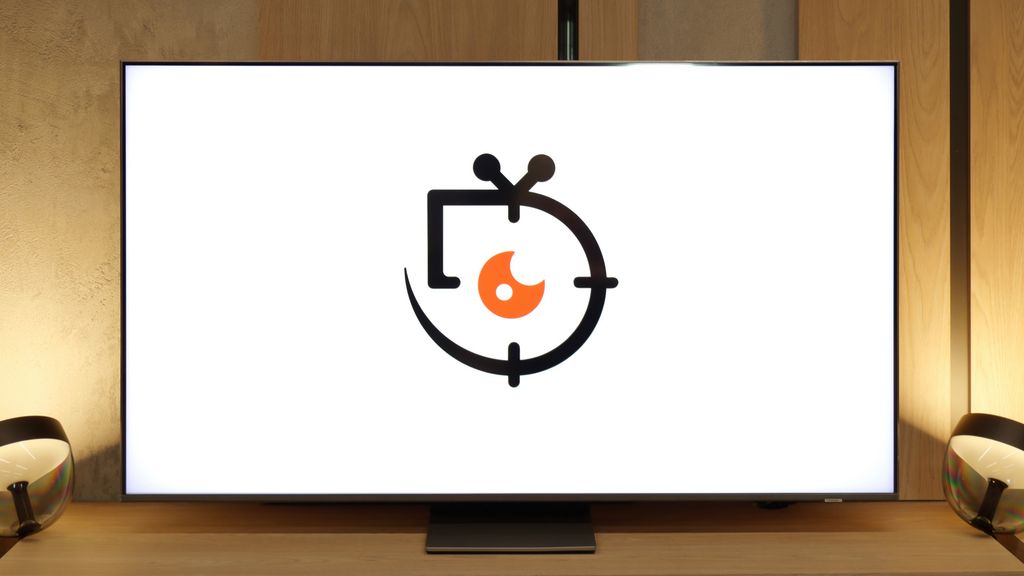
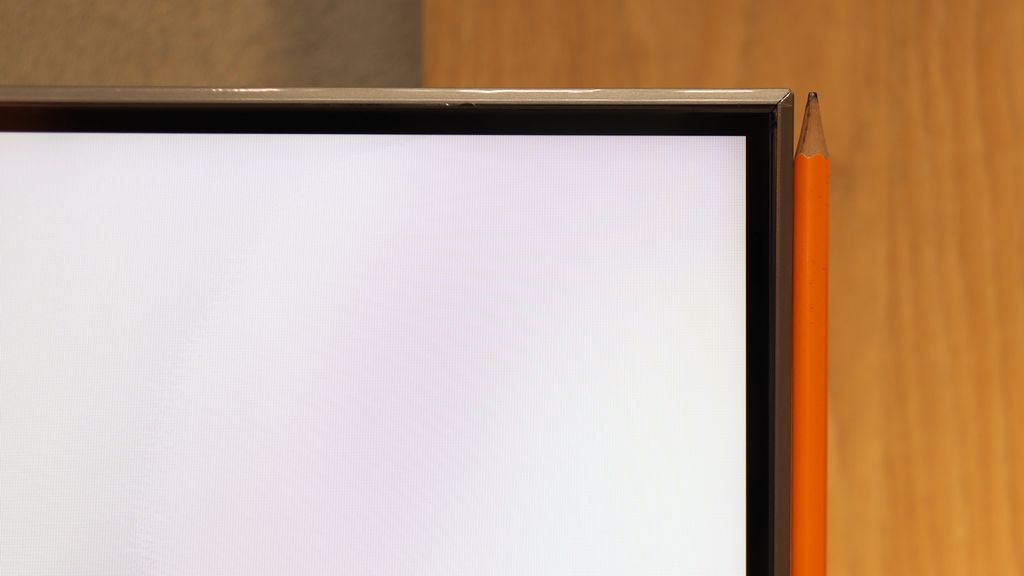
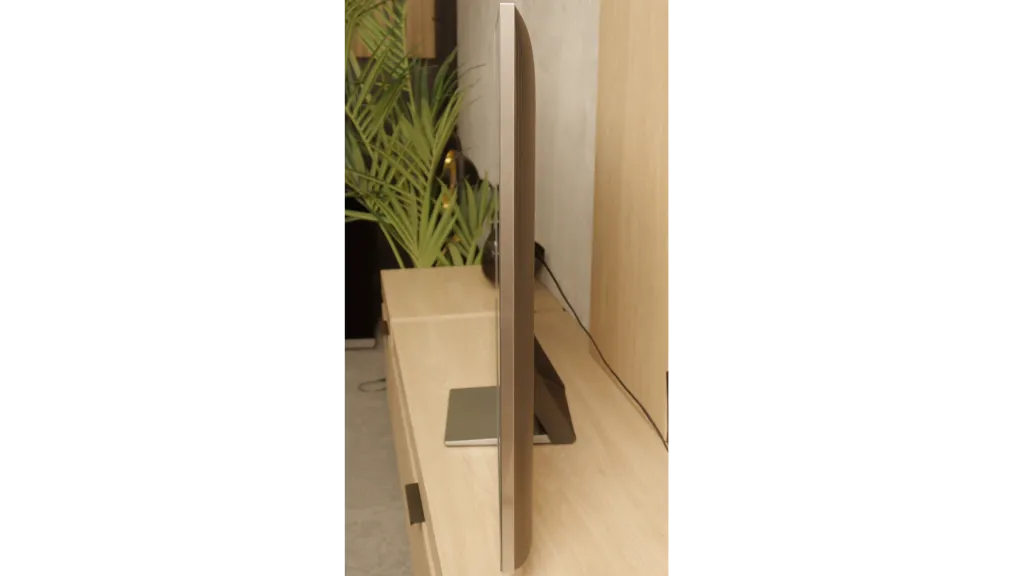
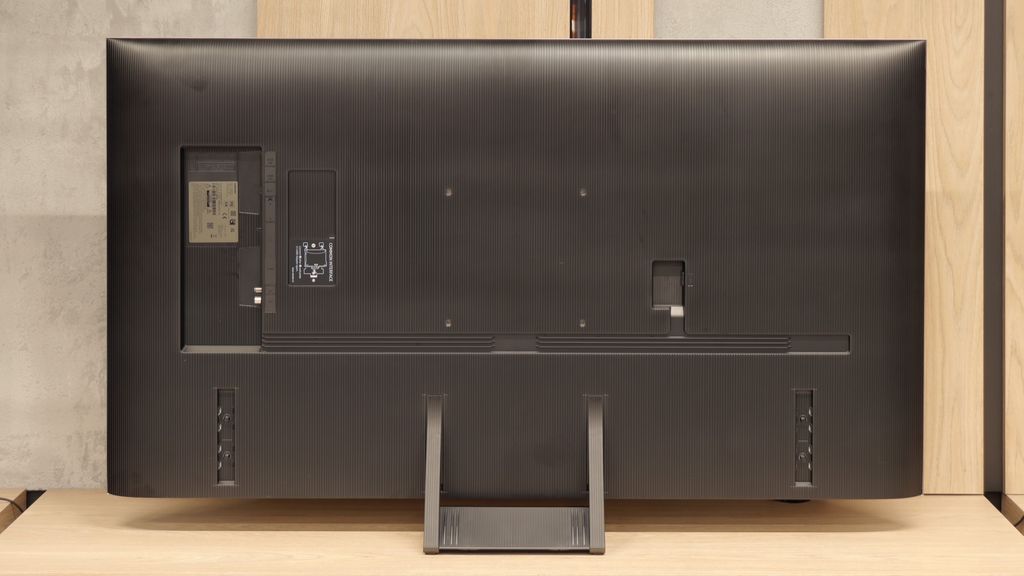
Contrast and black detail
7/10
7.5/10
Local dimming function: Yes, number of zones: 96 (16 x 6)
Local dimming function: Yes, number of zones: 240 (20 x 12)
Contrast:

Result
58,650:1

Result
37,150:1

Result
10,850:1

Result
6,150:1

Result
5,100:1

Result
101,800:1

Result
18,650:1

Result
47,050:1

Result
9,700:1

Result
4,350:1
Halo effect and black detail visibility:


The model name 8709 "PML" refers to Philips mini-LED technology, but can we really call its backlighting that? In the 65-inch version, we counted only 96 local dimming zones. For mini-LED standards, this number seems too low, which raises questions as to whether we are actually dealing with a true mini-LED here. However, if we look at the black quality, the television performs quite well. On the first two test patterns, as well as in less demanding scenes, the picture is quite decent – blacks are deep and contrast is satisfactory. Problems begin, however, in more complex scenes, such as the last three test patterns, where small light elements appear on the screen. The local dimming algorithm seems to "get lost," unable to decide whether to brighten or darken a given area. The result is visible errors – reduced black quality and unevenness of the picture. An example of the local dimming zones' operation can be seen in a scene from the film Sicario 2. You can see how the dimming zones try to reproduce details, but at the same time, this leads to a slight brightening around the helicopter lights. However, despite these shortcomings, the black level in the Philips PML8709 is quite good, especially considering its price class.
Our editorial office received a 55-inch model with a VA panel. In the case of NeoQLEDs, which are televisions with Mini-LED backlighting, size is of immense importance, as the larger the screen, the more local dimming zones it can contain. This directly translates to higher contrast. In the variant we tested, we counted as many as 240 dimming zones, which is twice as many as last year's QN85D. Theoretically, such an increase should bring an equally impressive improvement in contrast. Unfortunately, practice showed something different – the QN85F offers results very similar to its predecessor. Indeed, in certain scenes with a lot of black or in areas where details in the highlights are crucial, you can see progress, but it is not proportional to the number of zones themselves. Mini-LED technology can be capricious, and sometimes a slight halo appears around small bright objects. This is a typical compromise one must accept with such a solution. Nevertheless, the contrast in the QN85F is at a very high level and will comfortably satisfy most users, even those who are more demanding. However, we have the impression that Samsung could refine the algorithms controlling the dimming, as we know from experience that they can perform exceptionally well in other models.
HDR effect quality
4/10
6.9/10
Luminance measurements in HDR:

Result
367 nit

Result
126 nit

Result
309 nit

Result
119 nit

Result
348 nit

Result
1248 nit

Result
860 nit

Result
1093 nit

Result
465 nit

Result
957 nit
Scene from the movie “Pan” (about 2800 nits)


Scene from the movie “Billy Lynn” (about 1100 nits)


Static HDR10


Dynamic: HDR10+
Dynamic: HDR10+


HDR luminance chart:
Samsung QN85F
HDR luminance
Philips PML8709
HDR luminance
Looking at the results of the contrast, we expected that the algorithms responsible for the operation of zones in the Philips PML8709 would be at least decent. However, what we encountered during testing is difficult to explain. The average brightness we managed to achieve was only 350 nits, which is definitely too little to fully enjoy the effects of HDR. In practice, the television barely stands out against the backdrop of an average SDR. The situation becomes even more surprising for test scenes, such as the second one from the film Life of Pi or Sicario 2. Small light elements reach only 120 nits there, making them practically imperceptible. Such a level of brightness is completely at odds with contemporary HDR standards and significantly diminishes the experience of watching high-quality content. The only bright spot in this category is the very good coverage of wide colour gamuts – DCI-P3 at 97% and BT.2020 at 83%. This means that the colours are saturated and well-reproduced, which may improve the overall experience of watching HDR materials, if only a little. However, the lack of adequate brightness means that even this cannot save the Philips PML8709 in this category.
Although more than twice the number of dimming zones compared to its predecessor did not translate into a spectacular jump in black levels and contrast, we definitely felt it in the HDR effect itself. The QN85F is up to 50% brighter than last year's model, making a huge impression in dynamic scenes. The peak brightness can reach almost 1700–1800 nits, which is truly impressive for Mini-LED in this class. The best part is that almost regardless of the scene being watched, the HDR effect remains strong and vibrant. In four out of five test scenes, brightness was maintained around 1000 nits, a level that in most cases allows the viewer to experience the true magic of this format. Of course, in scene number 4 from the film Sicario 2, the limitations of Mini-LED technology become apparent – the brightness of the helicopter’s small light drops to around 500 nits. This result is not stellar, but it is still much more acceptable than last year's model. Samsung therefore deserves applause, as the improvement in brightness in the QN85F is drastic compared to its predecessor. However, it is a shame about a certain trend visible in this year's televisions – the manufacturer has worsened the colour gamut coverage. Although the QN85F has a QLED panel, its score of around 90% DCI-P3 is average, and in the most demanding films, it can lead to less vibrant colours than its predecessor. Despite this shortcoming, the overall HDR effect stands at an excellent level and truly makes a big impression in this class of devices.
Factory color reproduction
3.9/10
4.8/10


Factory Mode
After calibration


Factory Mode
After calibration
Although theoretically the Filmmaker mode on the Philips PML8709 should provide natural colour reproduction, in reality it resembles store mode more closely. In the white balance, both for HD and 4K content, there is a clear dominance of the blue colour. This causes the image to appear washed out and cold, which is particularly noticeable in the comparative photo below.
The brightness characteristics also leave much to be desired. Both the gamma and EOTF curve show excessive screen brightening. As a result, there is a loss of detail in both the brighter and darker areas of the image, which further diminishes its credibility and naturalness. Bright elements appear unnaturally flat and lacking in variety.
These significant issues in white balance and brightness characteristics lead to noticeable errors in colour reproduction, which can be easily seen in films as well as in the Colour Checker test. The colours are inaccurate, impacting the overall image quality and visual experience. The factory settings require significant improvement in order to fully enjoy the potential of this television.
Samsung QN85F offers several preset picture modes, but by default, when the television is turned on, it starts in "Eco" mode. And we could actually end the discussion here, because for such a model, using this setting makes no sense – the picture is washed out, unpleasant, and far from what we expect from a television of this class. We therefore carried out our tests in the best of the available modes, which is the Filmmaker mode. Its purpose is to faithfully reproduce what the directors saw during the filming of the movies, and indeed this is the setting that performs best among all factory options. However, this does not mean that it is without flaws.
Both in SDR and HDR, the QN85F quite strongly emphasised warm colours. This resulted from deficiencies in white balance, where there was a distinct lack of blue. Additionally, the picture was sometimes overexposed – as indicated by both the gamma brightness characteristic and the EOTF curve, which showed that the television tends to blow out scenes. In SDR, the colour reproduction errors (Delta E levels of 4-5) were still acceptable, but in HDR the discrepancies became quite large and clearly deviated from what the creators intended to show us. Fortunately, Samsung provides a wide range of calibration tools in its televisions, so – as always – we proceeded with professional calibration to see how much could be improved.
Color reproduction after calibration
7.6/10
8.5/10




Philips offers advanced image calibration tools in its televisions, which we decided to fully utilise. The results? Although we managed to improve many aspects, it was not without difficulties. White balance was one of the biggest challenges – despite our efforts, this can be described as a fight against windmills. We managed to correct it significantly, resulting in the image now looking much better than in the factory settings, but it is still far from perfect. Particularly in some scenes, a subtle dominance of blue is visible, although not as intense as before. We achieved a substantial improvement in brightness characteristics – gamma now appears much more stable. The EOTF curve initially looks correct, however, when analysing film content, it is evident that the television struggles to maintain the appropriate characteristics. The algorithms are "battling," trying to adjust brightness, which may stem from the limited number of dimming zones that do not always cope with more complex scenes. Overall, the image after calibration looks much more pleasing to the eye – colours are more natural, and errors in colour reproduction have been minimised. Although it is still not perfect, the Philips PML8709 now performs significantly better than in the factory settings.
After calibrating the film mode, we managed to tame the colours in both modes to near perfection – most of them did not exceed an error value of 3, which is the threshold of perception by the human eye. The image became more natural, fuller, and at the same time free from bloom, which was noticeable right after taking the television out of the box. This shows the great potential of the QN85F and how well it responds to precise settings. However, this does not change the fact that certain technological barriers cannot be overcome. Despite the enormous benefits of calibration, there are still limitations of the panel itself. Although the number of dimming zones has doubled compared to its predecessor, the algorithms controlling the backlighting can manipulate brightness in their own way. Sometimes this leads to slight colour inaccuracies or gently visible halo effects around bright objects. Nevertheless, the experience after calibration is truly pleasant and demonstrates how good a screen the QN85F can be if we just take a moment for proper settings.
Smoothness of tonal transitions
9.1/10
9/10












The fluidity of tonal transitions in the Philips PML8709 is at a very high level. The colour gradation is incredibly smooth, and the transitions between shades appear natural and detailed. Even in more demanding scenes, the television performs excellently. Minor issues may arise with bright elements, where the gradation may be slightly less precise. However, these are such subtle differences that only the most discerning purists will notice them. For most users, the effects will be fully satisfying, and the image will maintain its impressive quality.
Slight colour errors are often practically unnoticeable; it is the fluidity of tonal transitions that is a category to which even a less experienced viewer will pay attention. Unfortunate bands and artificial lines can completely spoil the perception of the image. Fortunately, the QN85F handles this aspect almost perfectly. Gradients are smooth, transitions between colours seamless, and there are no artificial streaks or harsh lines separating the hues on the screen. The image remains coherent, and nothing distracts our attention from the content. Only under very extreme conditions did we notice slight issues in the grey palette, but this is a drawback typical of most televisions and is hard to consider a serious negative. In practice, while watching films, we encountered no problems.
Image scaling and smoothness of tonal transitions
6.9/10
7.5/10
Smooth transition function


Image without overscan on the SD signal


The distortion reduction function in the Philips PML8709 smooths tonal transitions, but its effectiveness leaves much to be desired. We recommend setting this option to "Medium" – at this level, the effect is noticeable but not excessive. Unfortunately, compared to other Philips models, the smoothing effect is less effective, which means that certain tonal transitions may still appear a bit uneven. An additional drawback is that this function also smooths out other details, such as the textures of materials like a shirt, which can affect the sharpness of the image.
When it comes to image scaling, the television performs very well. The image appears plastic and free of noticeable "jaggedness." This effect may appeal to many users, although some may prefer a more pronounced appearance. Fortunately, the television allows for sharpness adjustment, and this enables us to tailor the image to individual preferences.
Although the native tonal transitions on the QN85F with 4K material perform excellently, we do not always deal with content in the highest resolution. At that point, it becomes crucial how the television handles upscaling and digital image processing. This process is managed by Samsung's proprietary processor – AI NQ4 Gen2. In practice, it operates very efficiently. If visible colour banding or other undesirable phenomena occur on the screen, for instance, in materials from YouTube, they can easily be smoothed out using the "noise reduction" feature. Set to a medium level, it improves tonal transitions without excessively blurring desired details. However, it is important to remember that – as with most Samsung televisions – this function heavily interferes with the film grain. Therefore, during cinematic screenings, it is wise to use it cautiously to avoid losing the natural character of the image.
The upscaling itself looks very good. Test materials in lower resolutions were displayed sharply and clearly, with a great deal of detail. The only downside remains the issue of overscan, which is the trimming of the edges of the screen. In most situations, this is not noticeable, but with very old materials below HD quality, there may be cases where a fragment of the image from the left side gets slightly cut off.
Blur and motion smoothness
5/10
7.7/10

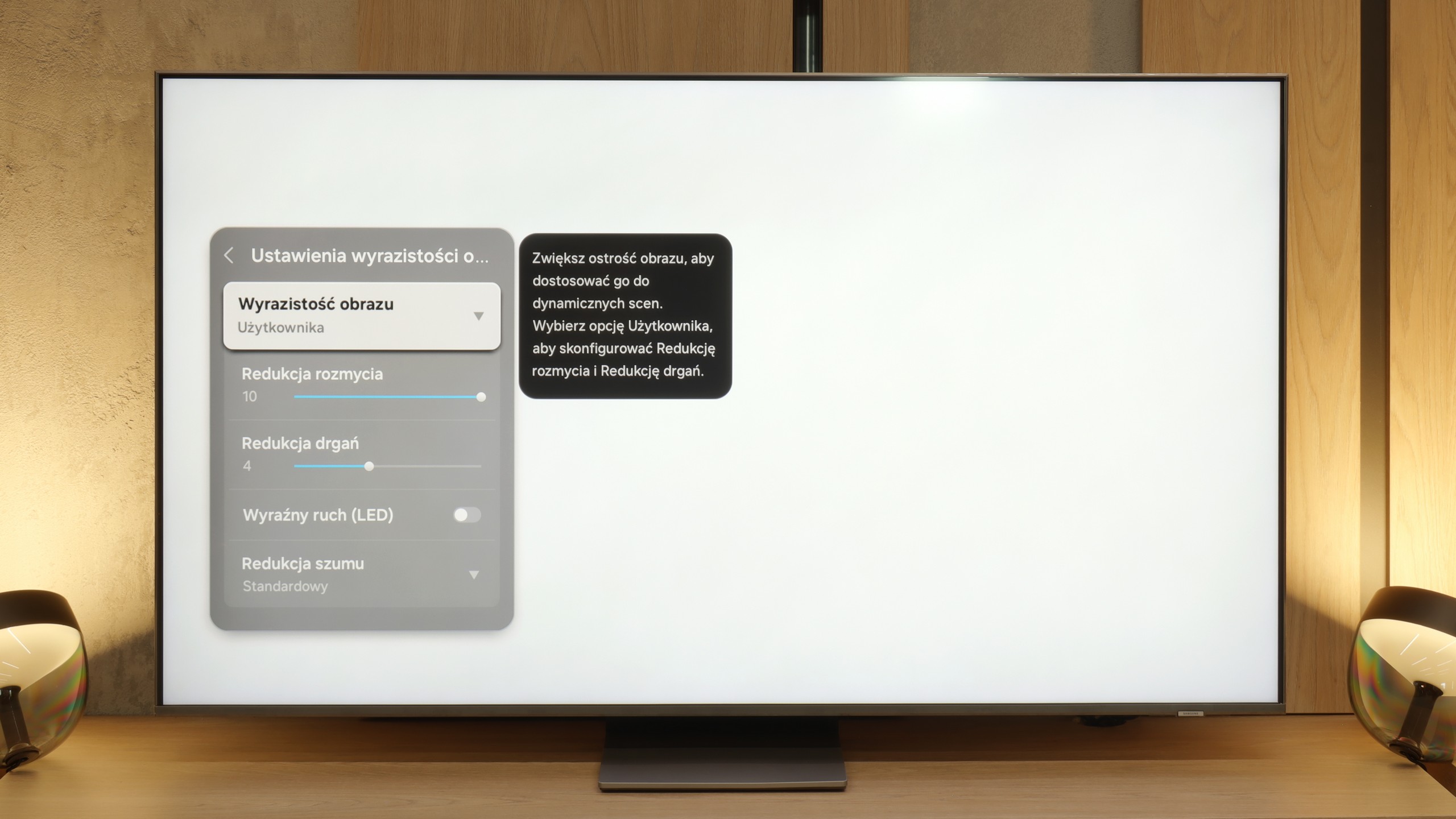
Blur (native resolution, maximum refresh rate):






Blur (BFI function enabled):
Image flickers in this mode



Smużenie ():
Smużenie (4K@144Hz):


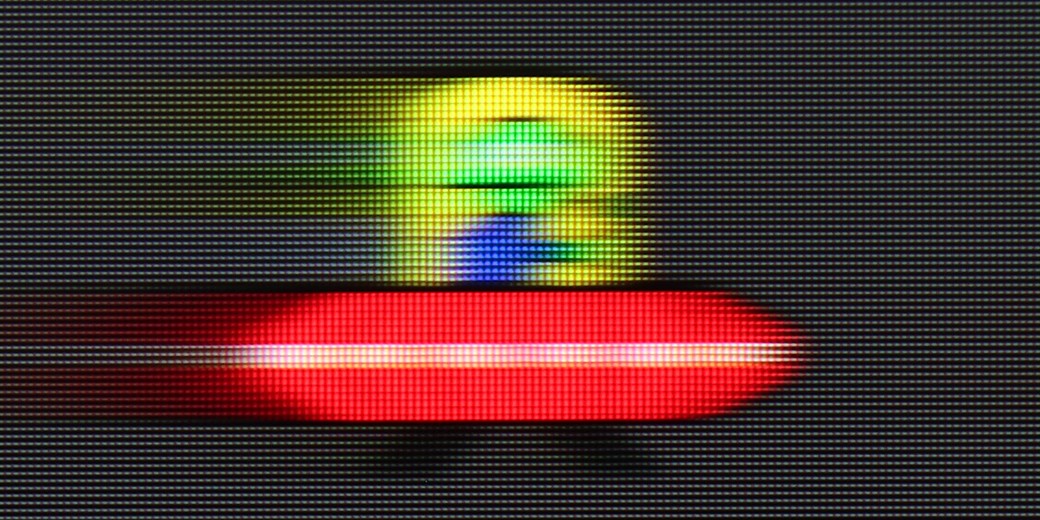
The Philips PML8709 is one of the few models with mini-LED technology on the market, offering a refresh rate of 60 Hz. Although it is not a panel for the most demanding gamers, it should satisfy those who mainly watch films. The television is equipped with the "Motion Style" function, which is a motion smoother that allows you to adjust the smoothness of motion according to preferences – from a more "plastic" look to a cinematic aesthetic with clearly visible frames.
Motion smoothing and fluidity in the QN85F is a topic worth discussing in more detail, as the television is equipped not with a standard 120 Hz panel, but with a 144 Hz one. The extra hertz will mainly be appreciated by PC gamers, but the mere presence of such an option can be seen as a nice addition and a sign of the times – it’s hard to complain about the trend towards faster panels, as in practice, each of us would prefer the image to be as smooth as possible. However, the most important thing is how the television handles typical 120 Hz refresh rates – in the case of consoles, sports, or films recorded at 24 or 30 frames per second. Here, the QN85F performs really well. In films, one can easily adjust the character of the image thanks to the "image clarity" function, where we find two adjustable sliders. Key for screenings is the one responsible for reducing judder. Lower values give the image a more cinematic character with preserved "frame rate," while higher values lead to strong smoothing reminiscent of television theatre.
Console compatibility and gaming features
6/10
8.2/10
- ALLM
- VRR
- VRR range48 - 60Hz48 - 144Hz
- Dolby Vision Game Mode
- Correct implementation of HGIG
- 1080p@120Hz
- 1440p@120Hz
- 4K@120Hz
- Game bar

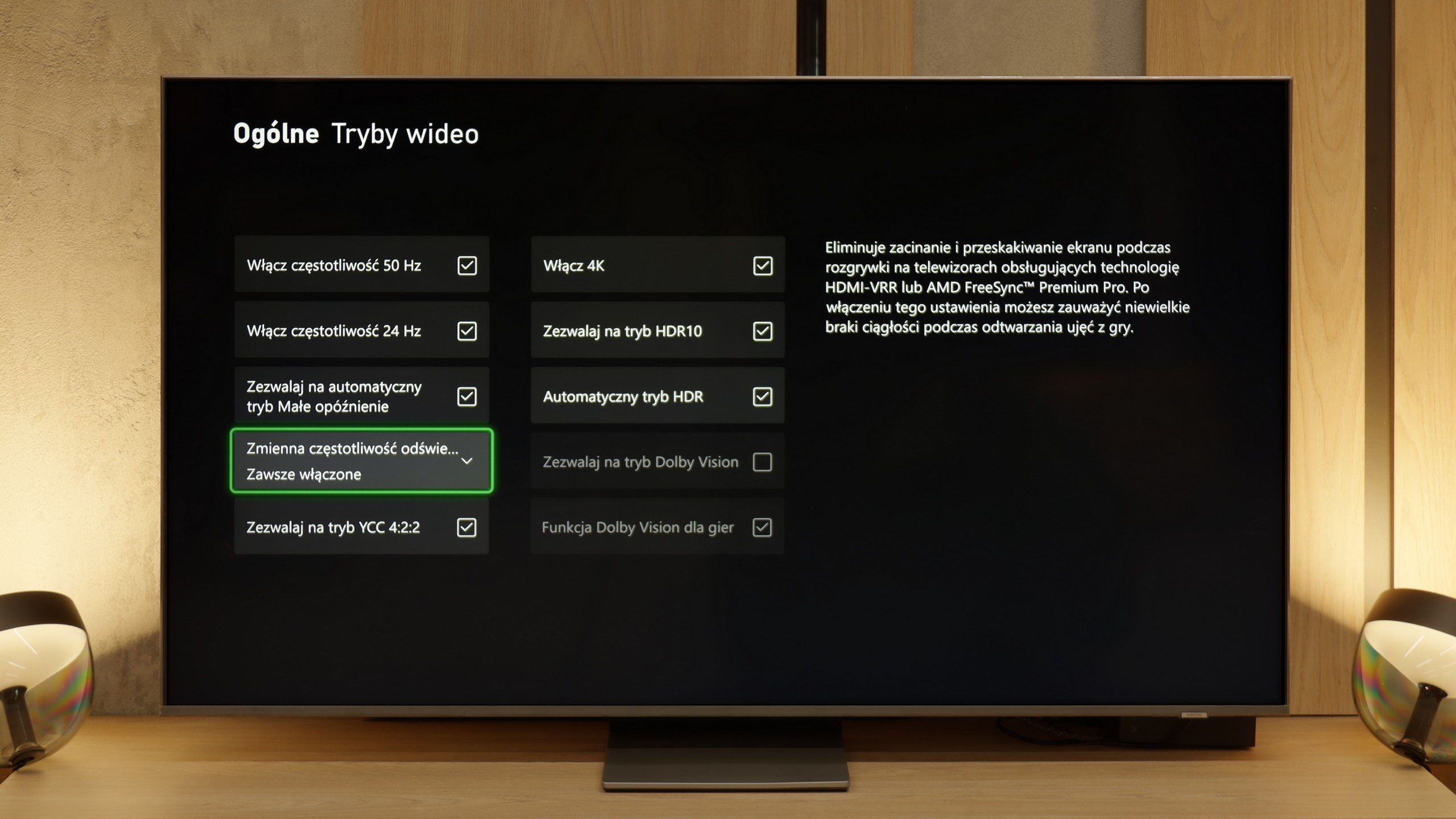

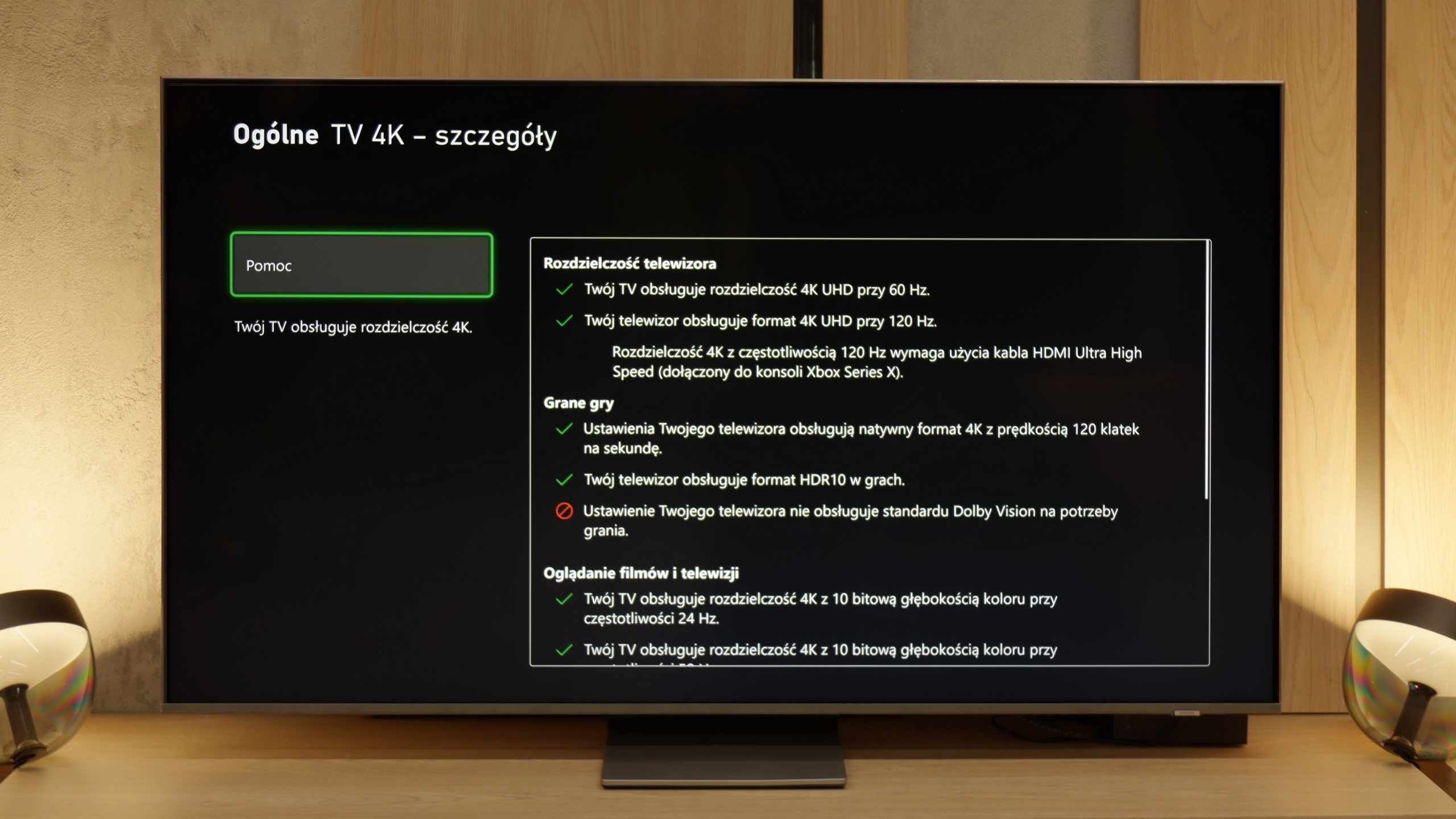

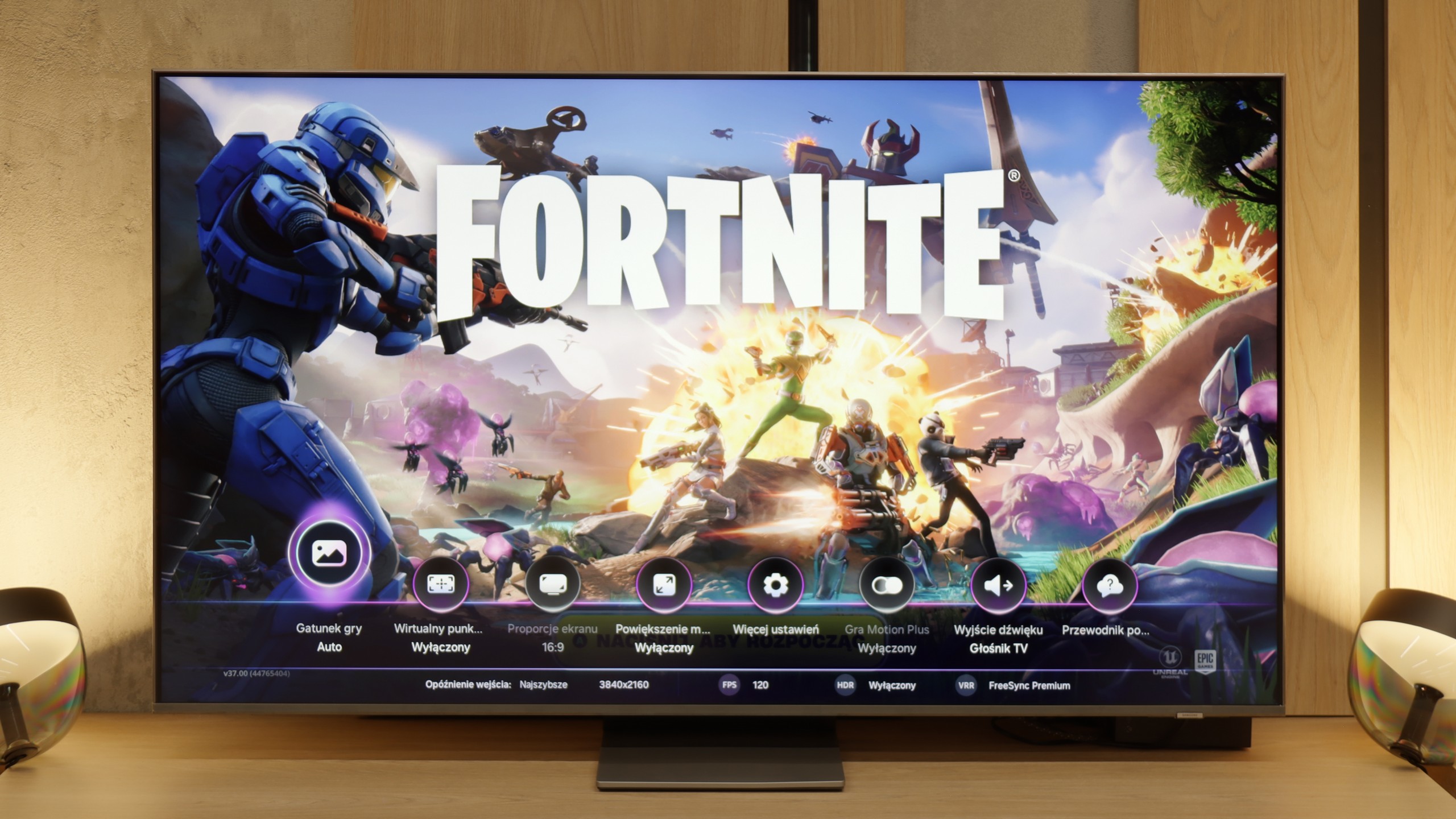

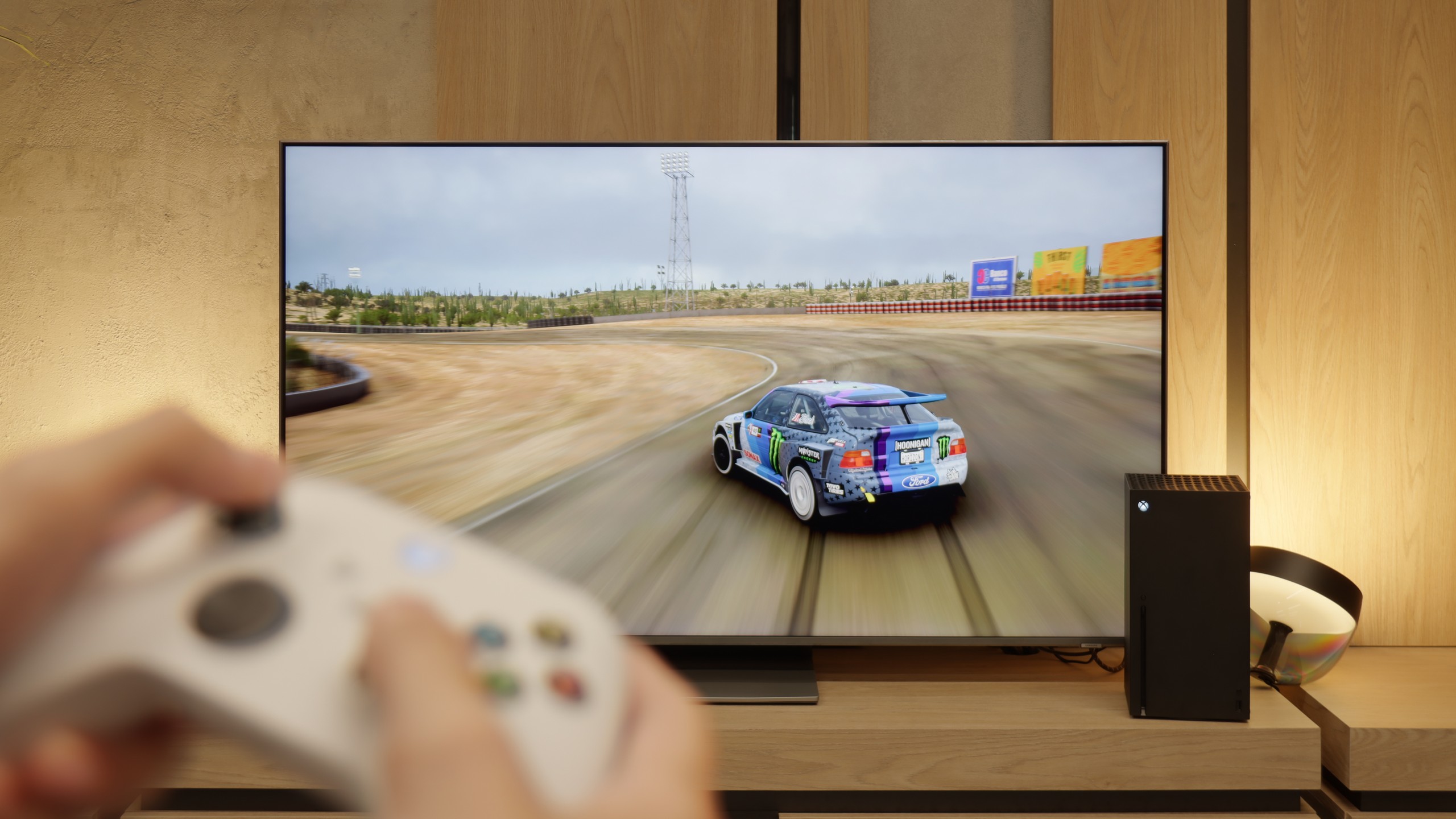
Philips PML8709 is a television aimed more at casual gamers, primarily due to its 60 Hz panel, which may not meet the expectations of the most demanding users. However, for those who appreciate gaming at a more measured pace, this model may prove sufficient.
The television offers several gamer-friendly features, such as ALLM (automatic switching to game mode) and VRR (variable refresh rate), which help deliver smoother visuals without annoying stutters. Furthermore, in terms of HDR, it includes an HGiG implementation that adjusts HDR effects to the specifics of games, providing a more natural image in properly optimised titles. Unfortunately, it lacks support for Dolby Vision mode, which may be noticeable in games that utilise this format.
A nice addition is the presence of a basic "Game Bar," which allows for quick viewing and modification of the most important gaming-related settings. This is a simple but useful feature, especially for those who often switch configurations between different types of gameplay. Despite some limitations, Philips PML8709 offers a solid set of features for less demanding gamers.
The Samsung QN85F makes a really great impression from the perspective of gaming features. We have four HDMI 2.1 ports here, so we can easily connect several devices simultaneously. There is also variable refresh rate (VRR) to prevent screen tearing, as well as automatic low latency mode (ALLM), which allows the TV to switch to the appropriate settings when we start the console. Additionally, it supports refresh rates of up to 144 Hz – something that PC gamers will particularly appreciate, but the mere fact that such an option is available shows that Samsung is committed to full support for gamers. The Game Bar panel also deserves praise. It provides a quick overview of key parameters – from frame count to refresh mode, right down to shortcuts for picture settings. Instead of digging through the entire menu, everything is at our fingertips, which turns out to be really convenient in practice. However, the most interesting addition is the Game Motion Plus feature. This is nothing more than a motion smoother brought into the gaming world. When turned on, the image becomes smoother, sometimes appearing as if we’re getting several more frames, and importantly – the response time doesn’t increase sufficiently to hinder gameplay. This is a solution that truly distinguishes Samsung's 120Hz televisions from the competition.
The only serious downside remains the lack of proper HGiG support. This is the standard responsible for proper tone mapping in HDR games, ensuring that brightness and contrast are displayed according to the creators' intentions. Without HGiG, we have to adjust the brightness manually, which doesn’t always result in the ideal outcome. The feature was available in previous models, but it disappeared in the QN85F after one of the updates. We hope that Samsung will quickly address this issue, and we will be monitoring whether it has been resolved.
Input lag
10/10
9.8/10
SDR
HDR
Dolby Vision
Philips PML8709 performs very well in terms of input lag. At the supported resolutions, results around 13 ms are more than sufficient to ensure comfortable gameplay. Such a response time means that even more dynamic games do not cause annoying delays. As a result, players can enjoy smooth gameplay without unnecessary stress.
The input lag on the QN85F is at a very high level. With content at 120 or 144 Hz, the values often oscillated below 10 ms, which is a truly remarkable result. Naturally, when gaming at 60 Hz, the lag doubles, but it still remains low enough that in practice it is virtually unnoticeable. This means that the QN85F will perform well both in dynamic e-sports games and in more tranquil console titles.
Compatibility with PC
3.5/10
8.4/10

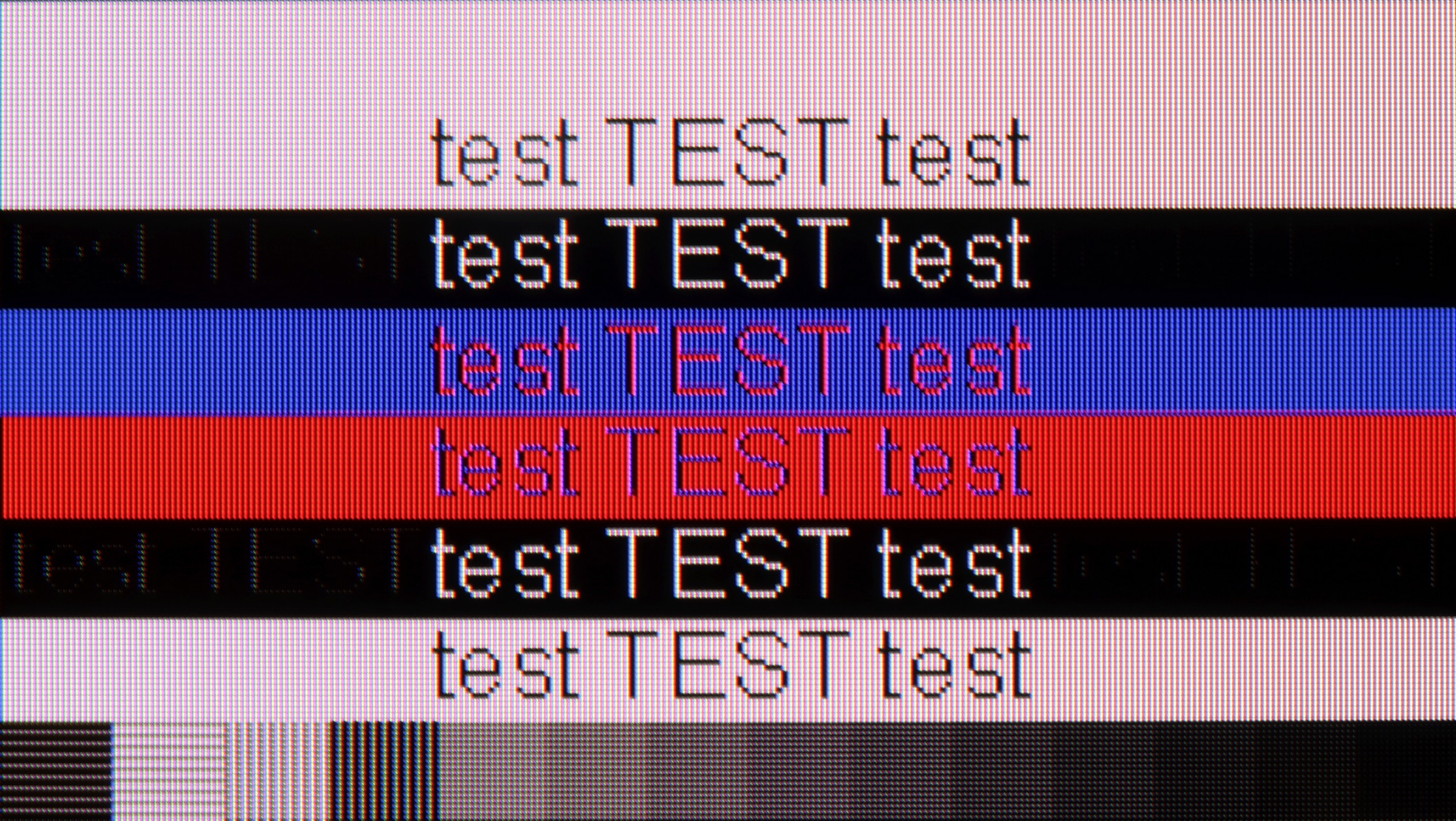
The Philips PML8709 offers a dedicated mode for PC, but its capabilities are quite limited. The television does not support chroma 4:4:4, which significantly affects the readability of fonts – text appears blurred and is difficult to read, disqualifying this model for those planning to use it as a monitor for work or document viewing. Additionally, although in G-Sync tests the television showed compatibility, the image when using this function is very unstable, with frequent stuttering. Such unpredictability eliminates the benefits that adaptive sync support should provide.
The only positive aspect in the context of working with a PC is the low input lag, which may be an advantage for those using the television mainly for gaming. Nevertheless, the limitations in chroma support and issues with G-Sync make the PML8709 less than ideal for PC users.
The QN85F performs really well in terms of cooperation with a computer. Thanks to the PC mode with a refresh rate of up to 144 Hz, support for G-Sync, and low input lag, playing on a personal computer is very enjoyable and shouldn't cause irritation even for more demanding gamers. The readability of the fonts is also good – the television supports chroma 4:4:4, so standard texts look sharp and clear. The problem arises only with very thin letters. Regardless of the refresh rate setting – whether it's 144, 120, or 60 Hz – horizontal, thin lines were poorly visible. Reducing the refresh rate slightly improved the situation, but never enough to say that they were displayed perfectly.
Viewing angles
2.9/10
3.2/10
The Philips PML8709, equipped with a VA panel, offers average viewing angles typical for this type of display. The image deteriorates in quality when viewed from a sharper angle – colours wash out and contrast significantly decreases. This is a characteristic feature of VA panels and it is worth keeping in mind, especially if we plan to watch the television from different positions in the room. However, for viewers sitting directly in front, the picture remains clear and well-reproduced.
The viewing angles on the QN85F are the classic Achilles' heel of most LCD televisions with VA panels. Looking at the screen from an angle, the drop in brightness becomes noticeable quite quickly, the whites start to grey, and the colours lose their intensity. This is the price to pay for the high contrast that this technology offers. Samsung could have included a better coating to widen the viewing angles in this model, but it is not present here. In practice, this means that the best viewing experience is achieved when sitting directly in front of the television, and any significant deviation will result in a noticeable loss of image quality.
TV efficiency during daytime
4.8/10
6.9/10

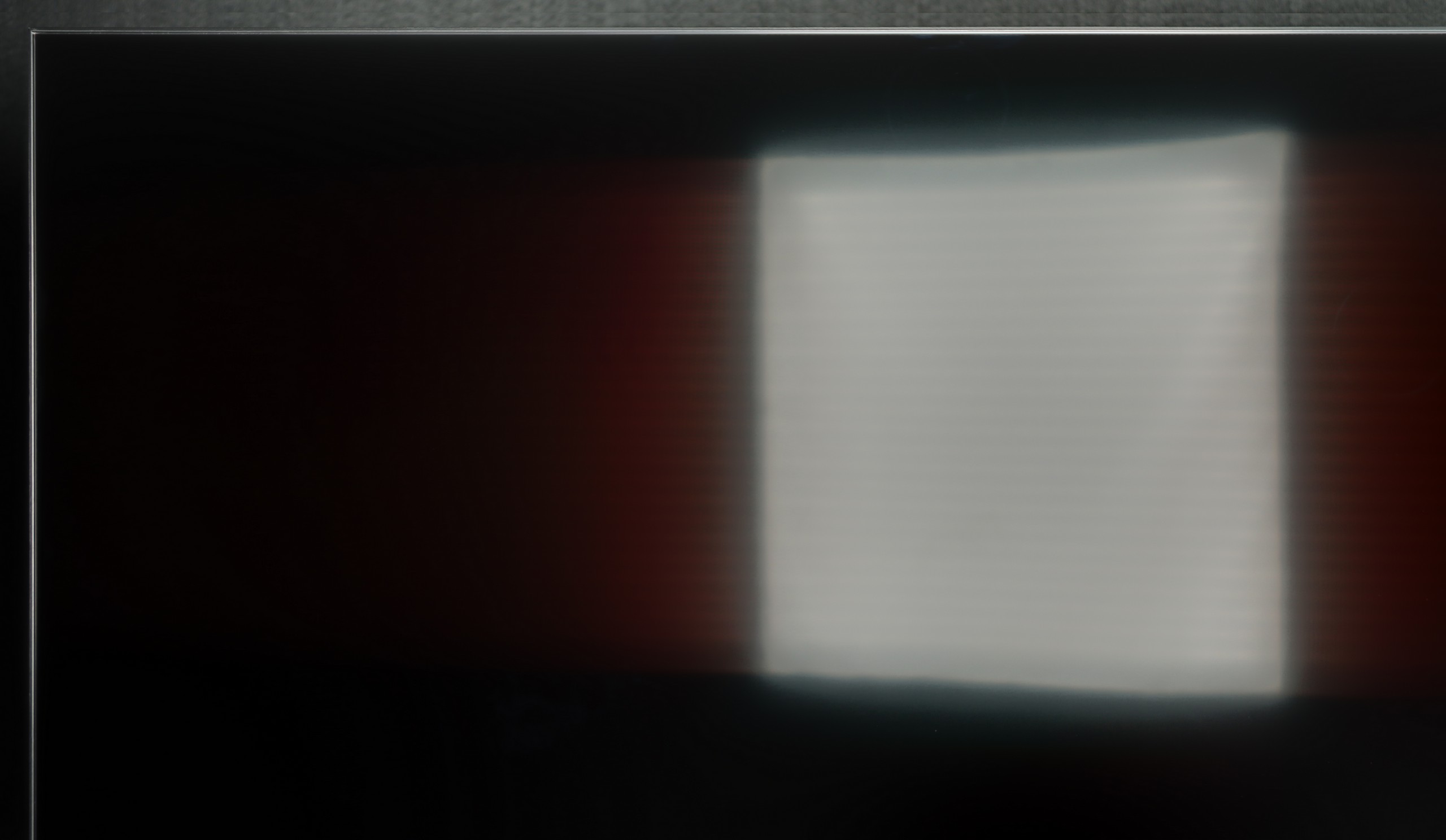


Matrix brightness
Average luminance SDR
Samsung QN85F : 690 cd/m2
Philips PML8709: 337 cd/m2
The Philips PML8709 is equipped with a satin matrix, which performs moderately well in reducing reflections. In moderately lit rooms, reflections will not be too bothersome; however, in heavily sunlit conditions, the situation can become problematic. An additional challenge is the relatively low screen brightness, measuring around 330 cd/m². This level may prove insufficient to ensure comfortable viewing in bright rooms, where the image may appear too dark and unclear. The television will perform better under controlled lighting conditions, but for those looking for a model that handles daytime viewing well, this may be a significant limitation.
The QN85F performs excellently during the day. The satin finish of the panel combined with high brightness makes it a television designed for bright rooms. Colours do not lose their intensity, and the picture does not fade even when a lot of light enters. The television itself is bright enough to handle a living room with large south-facing windows without any issues. Therefore, the QN85F provides us with an image that allows us to watch films or matches during the day without annoying reflections and the feeling that the picture disappears in the sunlight.
Details about the matrix
Subpixel Structure:

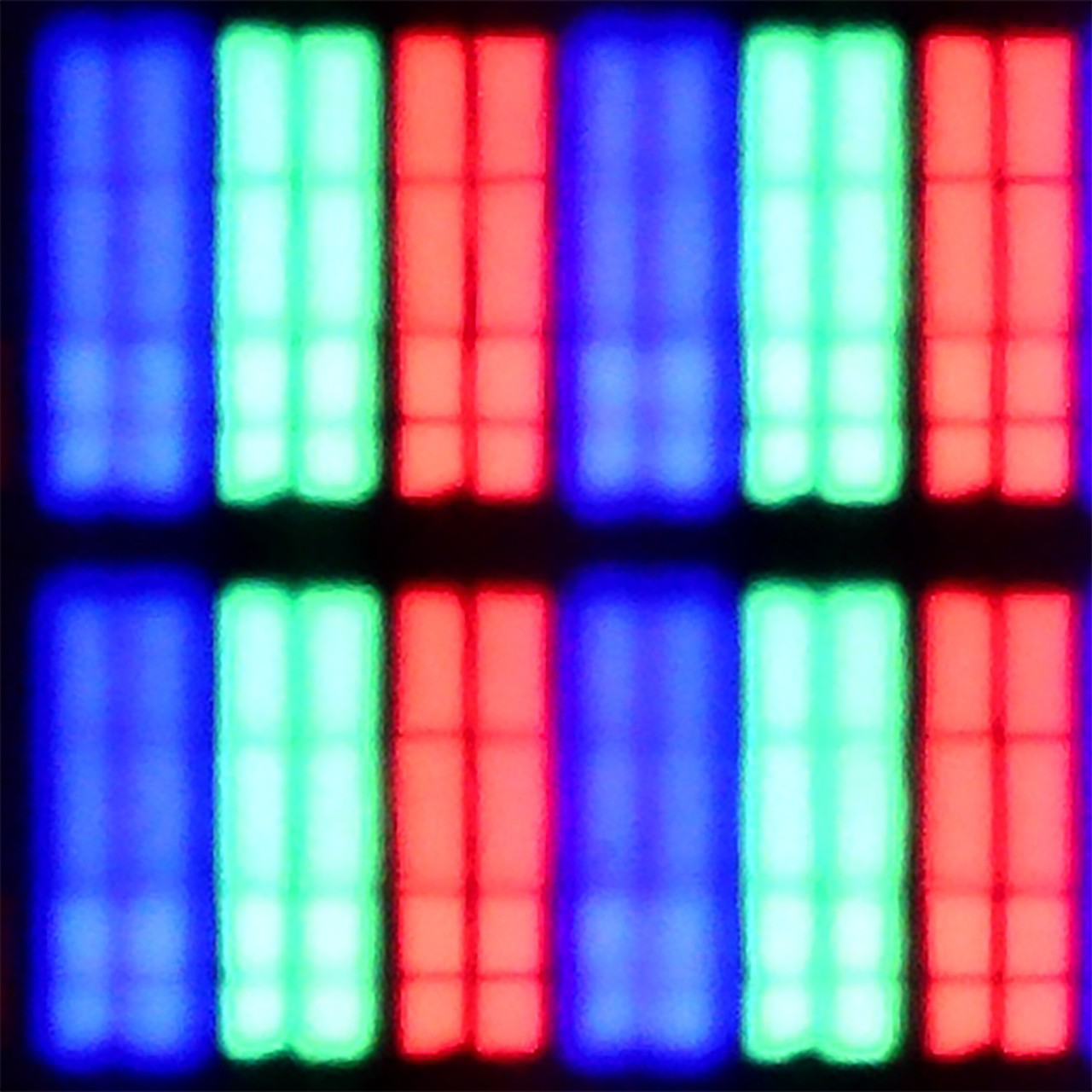
Panel uniformity and thermal imaging:


TV features
6.5/10
7.3/10
- HDMI inputs3 x HDMI 2.0, 0 x HDMI 2.10 x HDMI 2.0, 4 x HDMI 2.1 48Gbps
- OutputsToslink (Optical audio), eARC (HDMI), ARC (HDMI)Toslink (Optical audio), eARC (HDMI), ARC (HDMI)
- Network InterfacesWi-Fi 2.4GHz, Wi-Fi 5GHz, Ethernet (LAN) 100MbpsWi-Fi 2.4GHz, Wi-Fi 5GHz, Ethernet (LAN) 100Mbps
- TV receptionDVB-T, DVB-T2, DVB-S, DVB-S2, DVB-CDVB-T, DVB-T2, DVB-S, DVB-S2, DVB-C
Classic features:
- Recording to USB (terrestrial TV)
- Recording programming
- Picture in Picture (PiP)
- RF remote control (no need to aim at the screen)
- Backlit remote control
- Teletext
- Audio only mode
- Bluetooth headphones support
- Simultaneous Bluetooth headphones & TV audio
Smart features:
- AirPlay
- Screen mirroring (Windows Miracast)
- Voice search
- Voice search in native language
- Ability to connect a keyboard and mouse


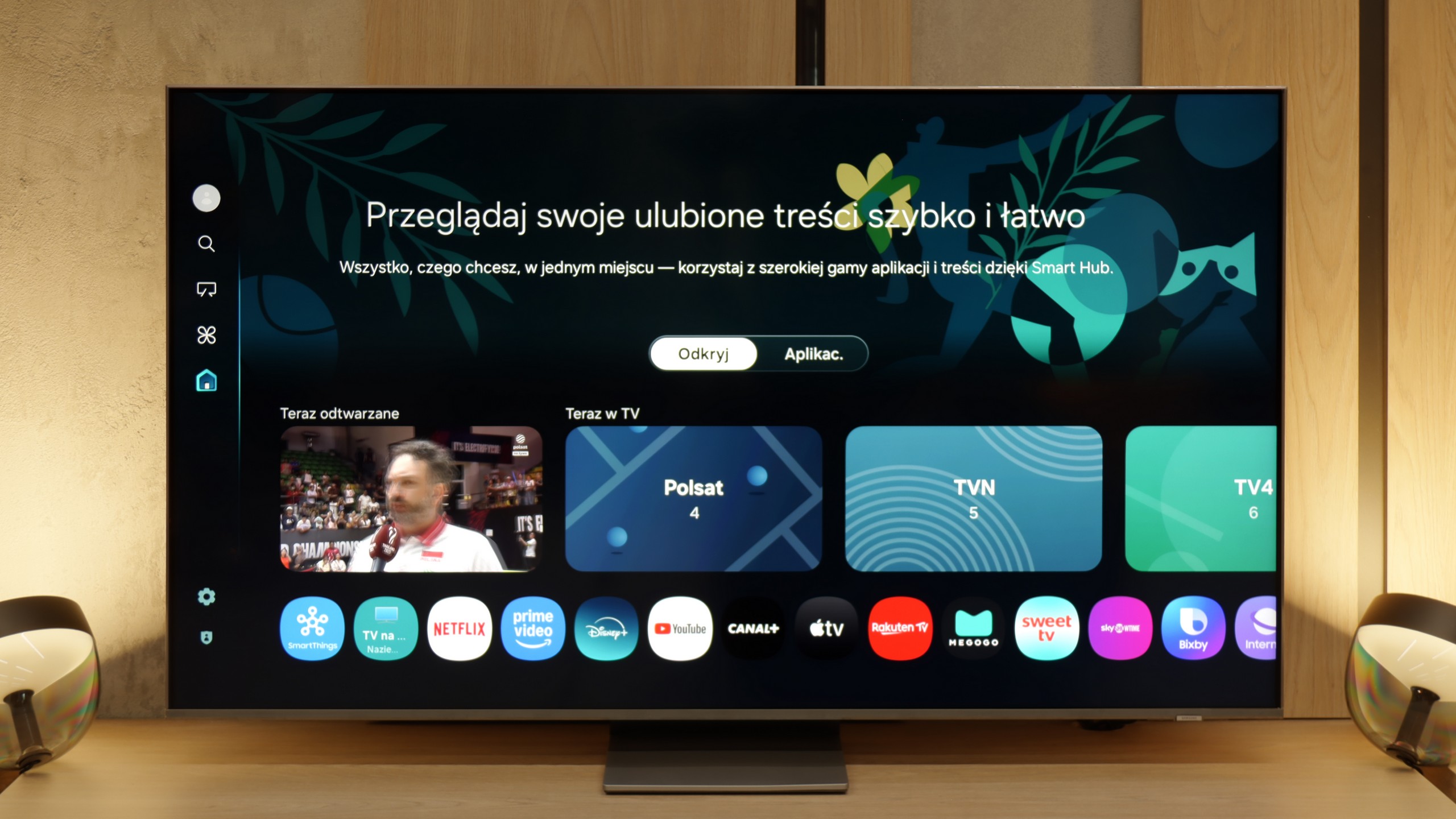
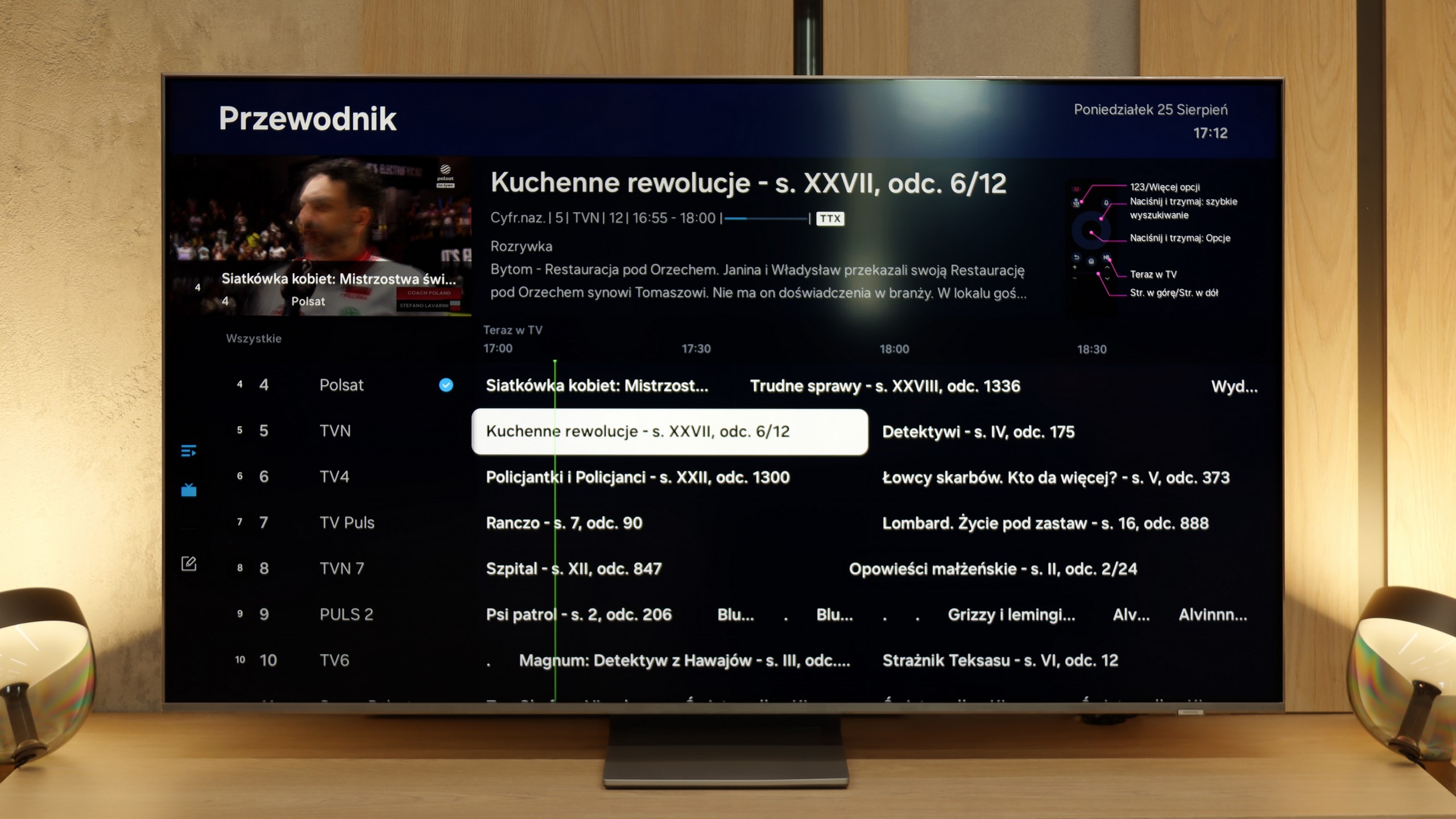
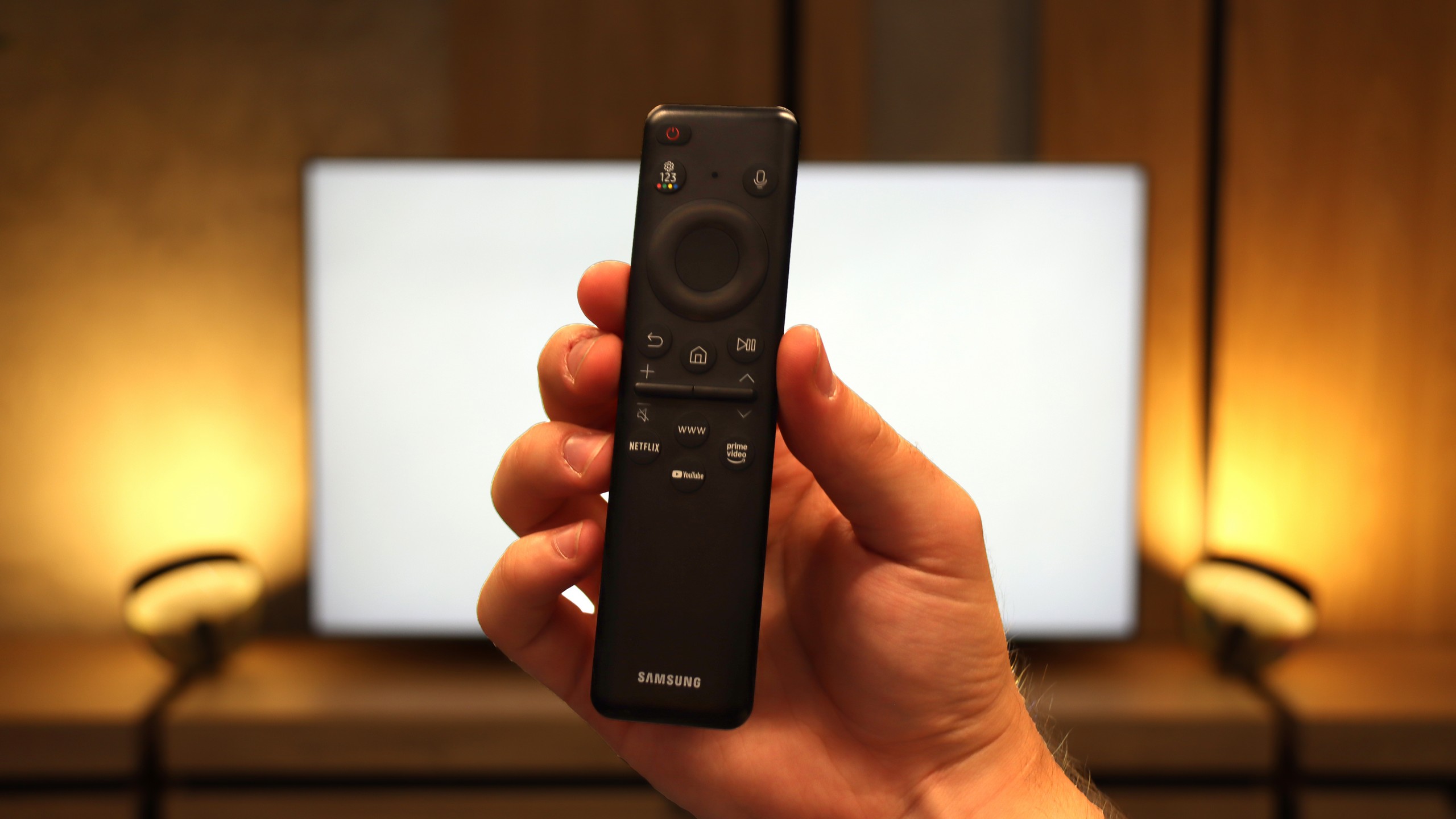
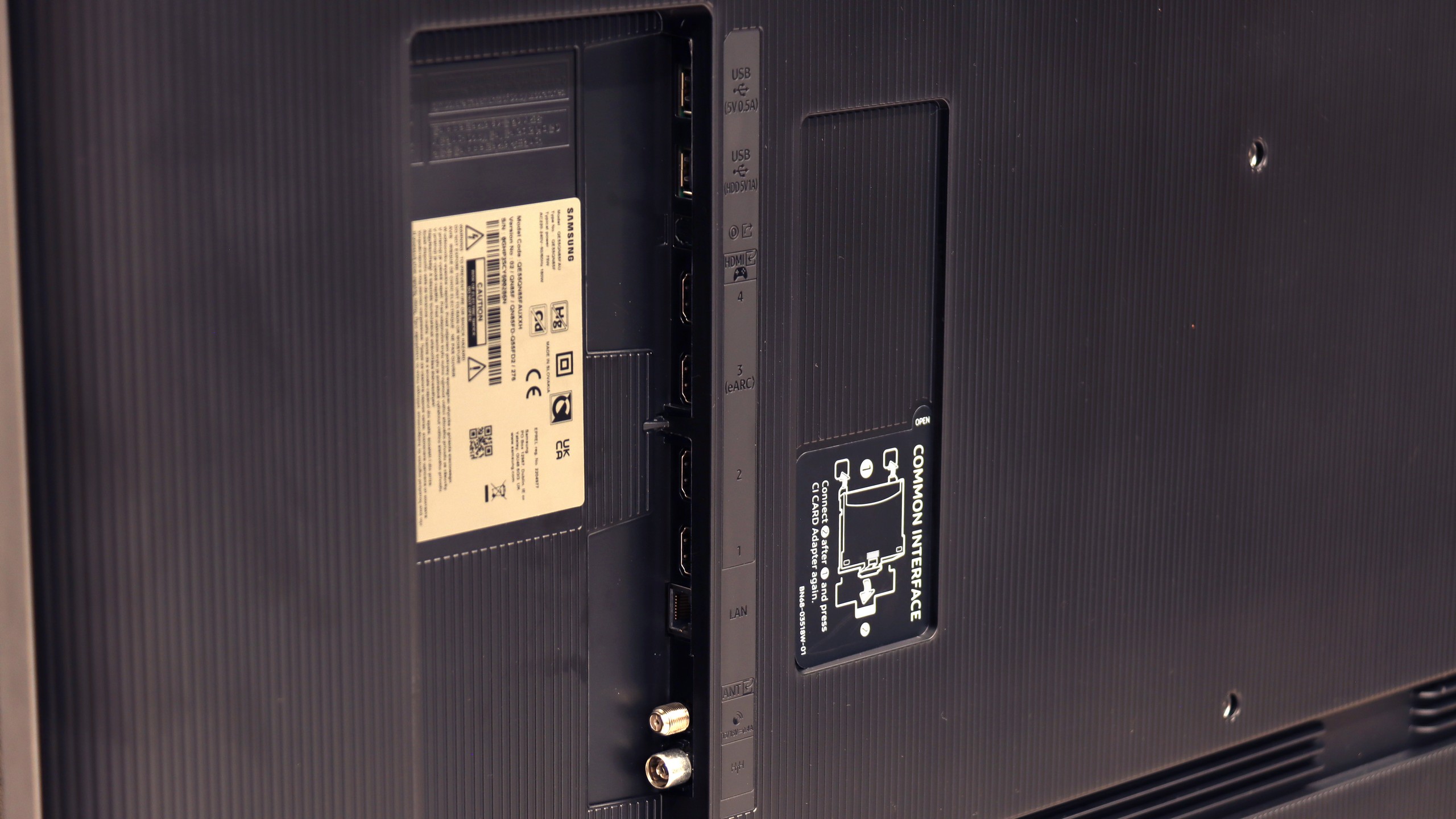
Philips PML8709 runs on the Google TV operating system. This is quite a surprising choice, considering that it is not a flagship model of the brand. Fortunately, it has avoided the implementation of the less popular TitanOS, which can be seen as a plus. Google TV offers a well-known, clear interface and wide possibilities for app installation, making the television more versatile.
In terms of usability, the television performs solidly. Daily use of the device is pleasant, thanks to support for voice search in Polish. The ability to connect peripheral devices such as keyboards, mice or headphones via Bluetooth increases its functionality. Unfortunately, the PML8709 does not offer more advanced options like USB recording or PiP (picture-in-picture) functionality, which may disappoint more demanding users.
An interesting fact, and quite a surprise, is the absence of the Ambilight system, for which Philips is widely known. The decision to omit this technology in the PML8709 model seems inexplicable, especially since Ambilight is often cited as one of the greatest advantages of televisions from this brand.
Smart TV and Tizen System
The Samsung QN85F runs on the proprietary Tizen operating system, which has been one of the strongest points of the Korean manufacturer for years. The platform operates quickly, is well-developed, and provides access to virtually all necessary applications. It supports AirPlay, allows screen mirroring, voice search, and has a very clear interface. It is all controlled by a remote with a minimal number of buttons, designed for quick access to the most important applications.
Classic TV Features
In terms of classic television functions, the QN85F offers a rather basic set. The EPG interface is readable and easy to use, resembling a traditional teletext programme list. A drawback is the lack of USB recording and the absence of PiP functionality, which Samsung has offered in many other models. This is due to the use of single tuners in the QN85F. For some, this may be a disadvantage, but considering how few viewers today use traditional linear television, it may not matter much to the majority of users.
SmartThings and Device Support
A strong element of the entire platform is the SmartThings application. Thanks to it, we can integrate the television with other home devices – not just those from Samsung. We can connect smart lighting such as Philips Hue or Yeelight, video doorbells, and many other devices to the system. SmartThings also allows us to control the television without using a traditional remote – we can use the app on a smartphone, mouse mode, or gesture control if we have a Samsung watch. This makes the QN85F part of a larger ecosystem and fits perfectly into the smart home IoT trend.
Playing files from USB
7.6/10
9.1/10
Supported photo formats:
Maximum photo resolution:

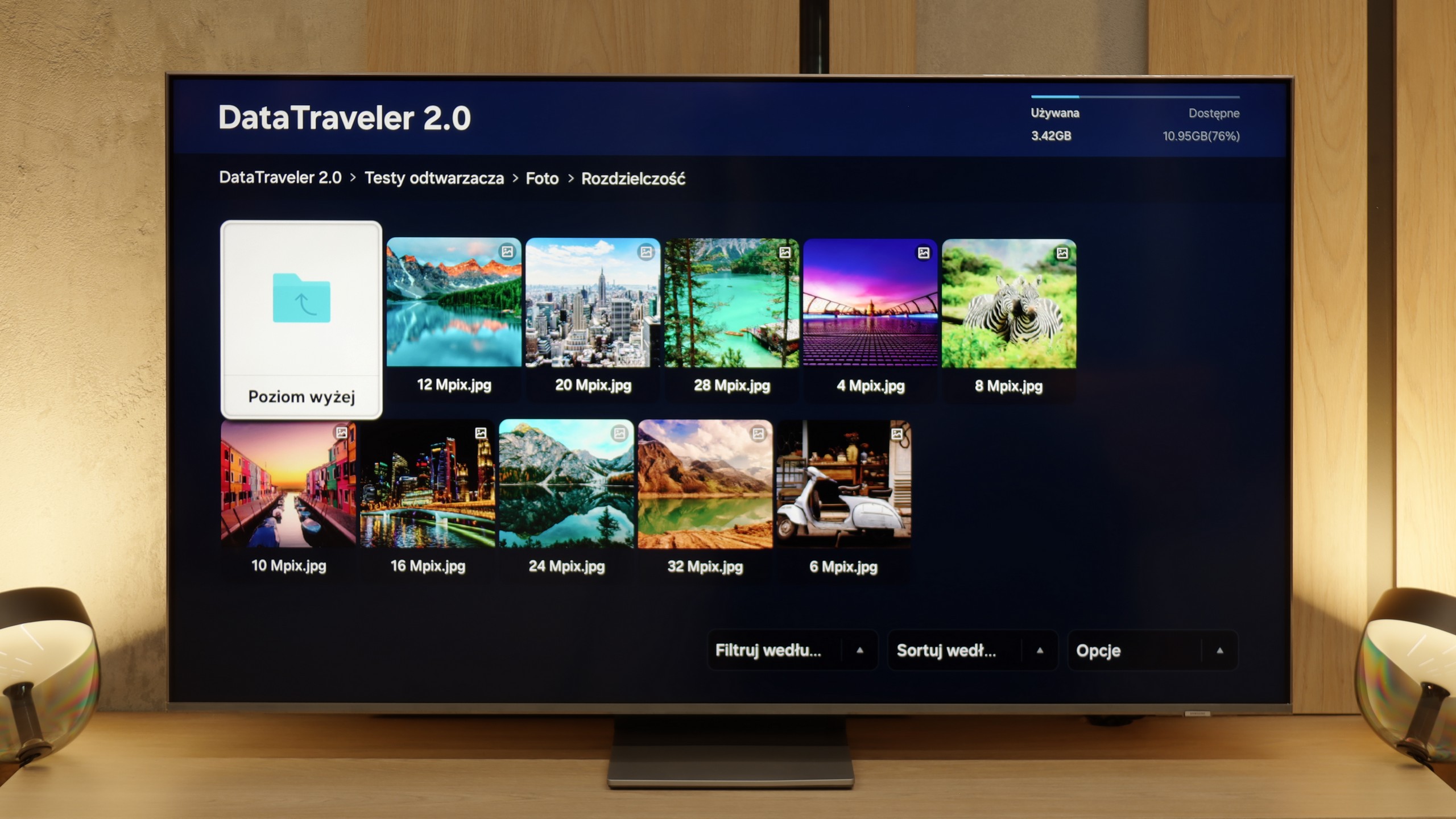
Philips PML8709 performs well in playing multimedia files from USB. The television should not have problems with handling most popular video, audio, and photo formats, making it a versatile tool for home entertainment. Files are read smoothly, and the interface of the built-in player is simple and intuitive.
However, a significant drawback is the lack of support for Polish characters in subtitles, stemming from the incomplete implementation of the UTF-8 standard. Subtitles with Polish characters are displayed incorrectly, which can be frustrating for those watching films in their native language. This shortcoming means that users seeking full compatibility with subtitles may be forced to resort to external multimedia players.
The player in the QN85F works as most people expect; it supports practically all popular formats and is more than sufficient for even the more demanding users. Movies, music, photos – everything runs smoothly. The only hiccup occurs with HEIC files, which are photos from Apple devices. According to the specifications, they should work, but in practice, they simply do not open. Thumbnails are visible, but the file refuses to launch. This seems to be a common software glitch. Aside from that one issue, the player performs well and does not give rise to complaints.
Apps
9.6/10
8.7/10














































Sound
5.1/10
7.6/10
- Maximum volume-84dB
- Dolby Digital Plus 7.1
- Dolby True HD 7.1
- Dolby Atmos in Dolby Digital Plus (JOC)
- Dolby Atmos in Dolby True HD
- DTS:X in DTS-HD MA
- DTS-HD Master Audio
The sound quality of the Philips PML8709 is average and standard for a television equipped with speakers rated at 2 x 10 W. The sound is sufficient for everyday viewing, but it is difficult to expect depth in the bass or clear details in more demanding scenes. On the plus side, it does support Dolby Atmos and DTS.
The Samsung QN85F is equipped with a 2.2 system with a power of 40 W, and when it comes to built-in speakers, it performs really well. The bass is pleasant, and the dialogues are clear and easily heard even during louder scenes. Even at maximum volume, the television does not produce any unwanted vibrations and nothing crackles. At the bottom of the casing, there is a subwoofer responsible for the bass – therefore, when installing, it is worth ensuring that it is not obstructed by anything.
As for formats, the QN85F does not support DTS:X audio, which has been a standard from Samsung for several years now, forcing Blu-ray enthusiasts to connect audio devices first to the home cinema and then to the television. However, in return, we receive support for the more popular Dolby Atmos format, which can add additional space to sound in films and series.
Acoustic Measurements
No acoustic data
84dBC (Max)
75dBC


